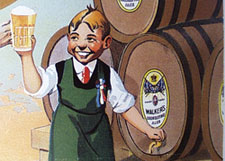 As I’ve written before, one of the categories here is Beer and Wine, not Beer versus Wine. When we have people over for dinner there will be men drinking wine and women drinking beer (and vice versa), and there might be a little conversation about one or the other but not why one is better than another.
As I’ve written before, one of the categories here is Beer and Wine, not Beer versus Wine. When we have people over for dinner there will be men drinking wine and women drinking beer (and vice versa), and there might be a little conversation about one or the other but not why one is better than another.
On our house, beer and wine are not opponents. White bread and processed cheese are the enemy. That’s why Natalie MacLean’s screed seems so silly.
On the other hand . . . If we were in the business of selling beer then I’d be at McLean’s door, pouring her samples of beer with “aromas that range from wet violets to toasty oak,” pairing them with various dishes and showing her clips of articles from people in the wine industry who are wringing their hands about what consumers in their 20s plan (variously known as Millennials or Geny Y) to drink this year and the next decade. It might be craft beer.
Consider this:
The wine industry could lose a generation of customers if it doesn’t get better at capturing the attention of younger drinkers, according to a survey commissioned by Vinexpo.
In a study of 100 occasional wine drinkers aged 20-25 (20 each in London, Paris, Brussels, New York and Tokyo), focus group participants said “they are curious about wine, but deterred by too many choices and styles, complex labeling and wine’s stuffy image.”
On the other hand, during the Craft Brewers Conference last month, Mike Kallenberger of Miller Brewing said, “The overall values and personality of the craft beer category will resonate even more strongly with adult Millennials than with Gen Xers and Boomers.”
Not that marketers don’t have 1,000 theories on Millennials. Outlaw Consulting recently released research that found Generation Y trendsetters are more drawn to brands that speak to them in a “straightforward and stripped-down way, use plain packaging, and avoid excess.”
The Most Trusted 15 brands named in the survey were:
1. Apple
2. Trader Joe’s
3. Jet Blue
4. In-N-Out Burger
5. Ben & Jerry’s
6. Whole Foods
7. Adidas
8. American Apparel
9. Target
10. H & M clothing stores
11. Levi’s
12. Volkswagen
13. Converse
14. Vitamin Water
15. Red Stripe Jamaican beer
I’m not sure that Samuel Adams is big enough to get wide enough attention to crack that list, and surely no other craft brewers are. But if you read the details you’ll be thinking, “That sounds like Uinta” or “That reminds me of Jolly Pumpkin.”
Does it seem like I’ve wandered off point? Here it is: We’re making a mistake any time we are less than inclusive. I’m rooting for Millennials to make good educated decisions when it comes to beer and wine because they’ll be a giant factor in which choices I have.
I’m not sure how many from Gen Y read McLean – or how many frequent this circle of blogs we hang out in – but I do know that her rant was the antithesis of inclusive. We should remember that when we discuss beer.
And here’s a wine example of the way to do it: Where the Homework Is a Pleasure.
 So what about that? And who to ask? How about brewers? I printed out part of Russell’s column and took it to the recent Craft Brewers Conference in Austin. I showed it to a dozen brewers along with another old saying that farmers make wine and engineers make beer.
So what about that? And who to ask? How about brewers? I printed out part of Russell’s column and took it to the recent Craft Brewers Conference in Austin. I showed it to a dozen brewers along with another old saying that farmers make wine and engineers make beer. I’m beginning to realize there is a chance I will break down and try Miller Chill. Got to be curious, right? Check out the number of posts at
I’m beginning to realize there is a chance I will break down and try Miller Chill. Got to be curious, right? Check out the number of posts at